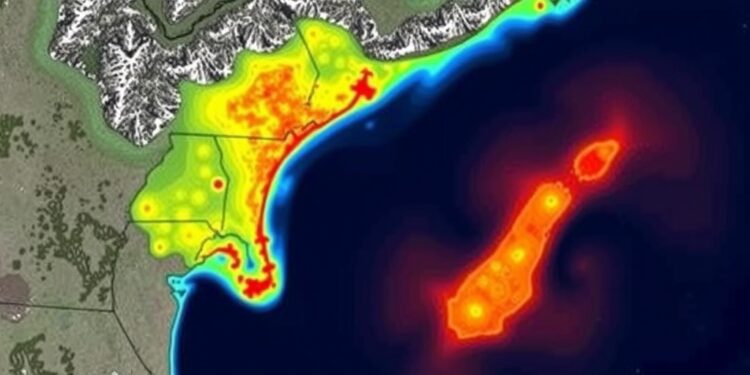Microplastics, the minuscule fragments of plastic that have emerged as one of the critical environmental issues of our time, are omnipresent in ecosystems across the globe. Ranging from less than one micrometer to several millimeters in size, these tiny particles are a byproduct of larger plastic items breaking down—through exposure to sunlight, water, and other environmental factors. Once released into the environment, microplastics can be transported widely, particularly into aquatic ecosystems. Recent research efforts have focused on understanding how microplastics accumulate and disperse within marine environments, with particular emphasis on coastal areas, which hold significant ecological importance.
The Texas coastal bays, known for their diverse marine life, including juvenile fish and oysters, represent crucial habitats threatened by various forms of pollution, including microplastics. While the prevalence of microplastic pollution has been documented worldwide, its specific effects and behaviors in estuarine environments—where freshwater and saltwater converge—remain poorly characterized. One notable incident highlighting the issue occurred in 2019 when a substantial spill of what are known as nurdles, small plastic pellets used in the production of plastic goods, occurred due to the Formosa Plastic Corporation’s operations in Point Comfort, Texas. This incident notably raised concerns regarding the accumulation of microplastics in the state’s coastal waters, prompting researchers to investigate the presence and distribution of these particles in the region.
A recent study published in ACS’ Environmental Science & Technology marks a significant step forward in understanding microplastic dynamics in Texas coastal bays. Led by researcher William Bailey and colleagues, the study aimed to map microplastic hotspots—areas with high concentrations of microplastics—by sampling sediment in various locations along the Gulf Coast. The researchers employed advanced microscopy and spectroscopy techniques to identify and analyze plastic particles and filaments, employing a systematic approach to categorize these materials based on size, shape, and density.
Interestingly, the findings from this study revealed lower-than-expected concentrations of microplastics within the sediments of Texas coastal bays. The research team had anticipated encountering higher levels of these particles, especially considering the historical data and incidents of nurdle spills. In particular, they observed that the highest concentrations were located near river mouths—where freshwater meets saltwater—indicating potential points for microplastic entry into marine systems. However, other areas showed similar abundances of microplastics regardless of their proximity to the shore, suggesting that distribution across various depths was more uniform than previously thought.
Bailey and his research team proposed several hypotheses to explain the unexpected results. They posited that activities related to local industries, particularly shrimp and oyster fishing, had a significant impact on sediment dynamics. The bottom-scraping techniques employed in these fishing practices can resuspend sediments and microplastics, thus redistributing these particles throughout the water column. Additionally, environmental factors such as strong winds and storm events that generate powerful waves can further disturb sediments, enabling microplastics to be transported from bays into the open Gulf of Mexico.
As a naturally lighter material compared to most sediments, microplastics tend to be buoyant, which allows them to be carried away from their original deposition sites and potentially into deeper oceanic waters. This raised an important question regarding the long-term fate of these particles and how they interact with marine ecosystems as they move into lower-energy environments. Understanding the pathways and transformations of microplastics once they leave the bays is essential for developing effective management and mitigation strategies.
The implications of the research extend beyond just the distribution of microplastics; they touch upon critical issues related to conservation efforts and the health of marine ecosystems. As microplastics can act as vehicles for other pollutants and toxins, their presence poses risks not only to individual marine species but also to entire food webs. The potential for microplastics to be ingested by fish and other marine organisms raises alarms about the cumulative effects on marine biodiversity and food safety, as they may ultimately impact human health through seafood consumption.
Looking ahead, Bailey and his colleagues are keen to apply their findings to create numerical models that can simulate the transport and deposition of microplastics along the Gulf Coast. These models aim to inform future conservation strategies and pollution mitigation efforts, particularly in understudied regions that face similar risks from microplastic contamination. Greater understanding and predictive capability regarding microplastic dynamics are vital for policymakers, conservationists, and researchers alike, as they navigate the complexities of pollution in marine environments.
In conclusion, the ongoing research into microplastics along the Texas coast highlights the pressing need to better understand these pollutants’ sources, fates, and impacts. With ongoing coastal development and industrial activities, continued vigilance is essential. Only through a comprehensive, multidisciplinary approach that considers physical, chemical, and ecological factors will we achieve meaningful strides in addressing the microplastic pollution crisis and safeguarding our oceans for future generations.
Subject of Research: Investigation of microplastic distribution in Texas coastal bays
Article Title: “Microplastics in Bays along the Central Texas Coast”
News Publication Date: 5-Mar-2025
Web References: http://dx.doi.org/10.1021/acs.est.4c12622
References: environmental science studies on microplastics
Image Credits: N/A
Keywords: microplastics, marine pollution, Texas coastal ecosystems, environmental science, pollution mitigation




